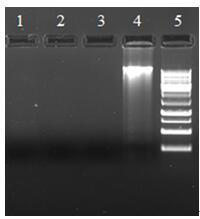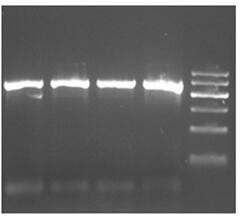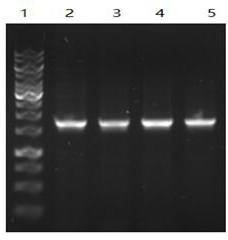Extracting micro viper gene and specific detection method thereof
A gene and trace technology, applied in the fields of biochemical equipment and methods, microbial determination/inspection, DNA preparation, etc., can solve the problems of missing the best time for treatment, blind treatment, unpublished whole genome sequence of Viper, etc. Achieve high sensitivity, good stability and good specificity
- Summary
- Abstract
- Description
- Claims
- Application Information
AI Technical Summary
Problems solved by technology
Method used
Image
Examples
Embodiment 1
[0055] Example 1: Viper gene-specific primer design
[0056] According to the nucleotide sequence of the viper gene in the Gen Bank database, the online software (http: / / www.ncbi.nlm.nih.gov) was used to perform Blast homology analysis and comparison, and the conserved and specific nucleotide regions were screened out. Use the primer design software to analyze the composition and stability of the base sequence, and comprehensively consider the principles of primer design, design multiple pairs of primers, and submit them to Shanghai Sangong for synthesis. The sequence of the primer pairs is as follows:
[0057] Table 1
[0058]
[0059]
Embodiment 2
[0060] Embodiment 2: Minor Genomic DNA Extraction
[0061] Take an appropriate amount of viper tissue or viper venom, put it in a centrifuge tube, add an appropriate amount of pure water with a final concentration of 100 μg / ml PK (i.e. proteinase K), incubate at 37°C, centrifuge at 12000g for 10min, suck the supernatant and put it in another centrifuge Then add an equal volume of balanced phenol, shake or invert to mix thoroughly, centrifuge at 12,000g for 10 minutes, absorb the supernatant aqueous phase and put it in another centrifuge tube, add an equal volume of 1:1 to mix and balance phenol:chloroform, then shake or invert to mix thoroughly , centrifuge at 12000g for 10min, absorb the supernatant water phase and put it in another centrifuge tube, add an equal volume of chloroform, oscillate or invert to mix thoroughly, centrifuge at 12000g for 10min, absorb the supernatant water phase into another tube, add 2.5 times the volume of cold absolute ethanol to freeze Store for ...
Embodiment 3
[0063] Embodiment 3: PCR amplification reaction
[0064] 1. PCR reaction conditions
[0065] PCR reaction system includes: total volume 20μl, 10XPCR buffer 2.0μl; 10XdNTPs 2.0μl, 0.2-1.5μl primer P-F (final concentration: 0.2μmol / l-1.5μmol / l); 0.2-1.5μl primer P-R (final concentration: 0.2μmol / l-1.5μmol / l); 0.4μl-2μl Taq enzyme (5U / μl, final concentration: 0.1 U / μl-0.5U / μl); DNA template 0.5μl; double distilled water 10.5μl-14.7μl.
[0066] The PCR reaction conditions are:
[0067]
[0068] 2. Optimization of PCR reaction conditions
[0069] The preferred PCR reaction system is: total volume 20μl, 10X PCR buffer 2.0μl; 10XdNTPs 2.0μl, primer P-F final concentration 0.5μmol / l; primer P-R final concentration 0.5μmol / l, Taq enzyme final concentration 0.25U / μl; DNA template 0.5μl; make up to 20μl with double distilled water.
[0070] Primer pair 1: The preferred PCR reaction temperature and time are:
[0071]
[0072] The preferred PCR reaction temperature and time for ...
PUM
 Login to View More
Login to View More Abstract
Description
Claims
Application Information
 Login to View More
Login to View More - R&D
- Intellectual Property
- Life Sciences
- Materials
- Tech Scout
- Unparalleled Data Quality
- Higher Quality Content
- 60% Fewer Hallucinations
Browse by: Latest US Patents, China's latest patents, Technical Efficacy Thesaurus, Application Domain, Technology Topic, Popular Technical Reports.
© 2025 PatSnap. All rights reserved.Legal|Privacy policy|Modern Slavery Act Transparency Statement|Sitemap|About US| Contact US: help@patsnap.com



